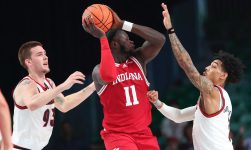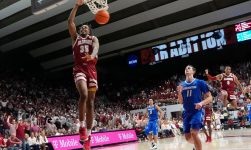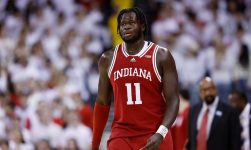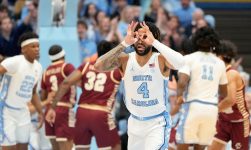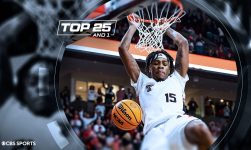BYU fans cheer on the Cougars during victory over Texas in the Marriott Center in Provo on Jan. 27, 2024. The addition of new coach Kevin Young and some top-tier recruits have excited the fanbase in Provo. | Nate Edwards, BYU Photo
Kevin Young is taking advantage of an era of NIL in college basketball that 70 years ago may have had then-BYU President Ernest L. Wilkinson on the warpath.
Conservative and carefully plodding forward when the NCAA approved payment of athletes for name, image and likeness, BYU basketball is now using one of the country’s most lucrative NIL collective operations in signing the 2024-25 roster.
These are the times.
Critics of BYU, primarily the usual naysayers who want BYU out of the sports business, point to all this coin going against the mission of the university.
Nah. It’s been decided in a court of law, brought on by suits against the NCAA. Most recent court settlements direct conferences like the Big 12 to plan on paying athletes a salary to the tune of more than $20 million per school per year.
“We’ll just have to adjust and go forward now,” BYU athletic director Tom Holmoe told me in June.
So, how does this relate to the approach 70 years ago?
Back then, BYU President Wilkinson believed deeply in amateurism. He was a purist. He believed athletes should perform on the field and courts because of their love, passion and dedication to the sport, and any hint of professionalism should be avoided at all costs.
Wilkinson pushed back against giving athletes scholarships because it would appear to blur the line toward professionalism.
Imagine.
Shortly after BYU’s Board of Trustees hired Wilkinson, a Harvard graduate and attorney, the Cougar basketball team won the 1951 National Invitational Tournament.
In a meticulously researched book out this summer, “100 Years of BYU Football,” by Duff Tittle and Brett Pyne (Deseret Book), the authors found a unique chapter focus on the Wilkinson era, in which he bucked the idea of recruiting athletes with benefit offers.
Wilkinson publicly proclaimed in October 1951, “Athletes should neither be given special favors nor be discriminated against. Unfortunately, at some universities there has been a double standard in administration, discipline, financial aid and academic standards.”
Wilkinson wanted to make sure BYU athletes were not receiving preferential treatment, more than their “proportionate share” of financial aid from the school and special treatment in “housing, registration and employment.”
In the meantime, other schools were recruiting using all these benefits, and generally kicking the crap out of BYU in football, especially in the Mountain States Conference, of which BYU was a charter member.
Wilkinson’s initial answer to discrepancies on campus “was to offer more benefits to scholars, debaters and drama and music students.” He then restricted special treatment in regards to housing and employment for athletes. His move drew praise from some faculty and concern from the athletic department and coaches, who saw it as a drawback in attracting athletes.
By the following spring, Wilkinson discovered just how common it was in the Mountain States Conference to recruit athletes and offer benefits and he changed his tune. He worked with the conference to create a uniform set of guidelines for recruiting with benefit offers.
Shortly after, a national committee on the Athletic Policy of the American Council of Education recommended “advocating institutions awarding scholarships and grants in aid to students on the fundamental basis of demonstrating academic or athletic and economic need.”
In those days, BYU athletic director Eddie Kimball worked diligently to convince Wilkinson to bring BYU up to par with competitors.
In a letter to Wilkinson May 11, 1953, Kimball said:
“Students, alumni, and other Church members will lose interest in our teams and our school. Our income will substantially be reduced because people will not pay to see losing teams, our teams will soon become the ‘doormat’ of our conference. It will increasingly become more difficult for us to secure a sponsor for our athletic broadcasts; there will be increased public insistence that there shall be winning teams or that losing coaches will be released; we will be unable to schedule teams of national prominence; and perhaps most importantly we will (have) lost the publicity, which has proved so valuable to the Church and school in proselyting members and students and creating goodwill for the Church.”
Legendary and future Hall of Fame coach Stan Watts entered the fight. Watts, who would later recruit Hall of Famer and European superstar Kresimir Cosic to Provo, proved prophetic when, four months later, he wrote a memo to Wilkinson, citing how hard Wilkinson’s reticence in leveling the recruiting field was hurting his program.
“Unless we have similar opportunities to attract outstanding athletes, and have an equal chance with our opponents, our athletic program will decline rapidly. We assume we are following the rules with the boys (recruits) we contact, only to find differences in the interpretation, placing us in an awkward position.
“Schools are not interpreting the rules as we are. By the time this issue is settled, the other schools will have the top athletes. Consequently, our athletic program will weaken accordingly.”
It took three years of this kind of lobbying and politicking of Wilkinson to bring BYU up to what it needed to be. Wilkinson then set the stage for a remarkable stretch of BYU athletics, both in facilities and achievements on the national scale, including the 1984 national championship in football.
Fast-forward to this summer.
In a state-of-the-art basketball annex next to the Big 12′s top-attendance basketball arena, the Marriott Center, Young is taking his team through skill development sessions.
BYU players listen to coach Kevin Young during practice at the Marriott Center Annex on June 6, 2024, in Provo. | Nate Edwards, BYU Photo
By all reports, top recruited Russian Egor Demin, who Young signed out of Real Madrid with a lucrative NIL deal, is proving every bit of his reputation as a future lottery pick. He is putting on a display of remarkable flexibility at playing all five positions as a 6-foot-8 point guard, a player destined to bring fans to their feet in the nearby arena.
He’s joined by what is inarguably the best recruiting class ever signed by BYU.
In retrospect, Wilkinson, who famously would bring fans to their feet in the Smith Fieldhouse by doing pushups on the court, would indeed be pleased.
Either that or he’d be spinning in his grave.
His dream of amateurism not only died a long time ago, but is a distant memory in the wake of today’s NCAA that has become the real Wild, Wild West in recruiting, NIL and the crazy transfer portal.

